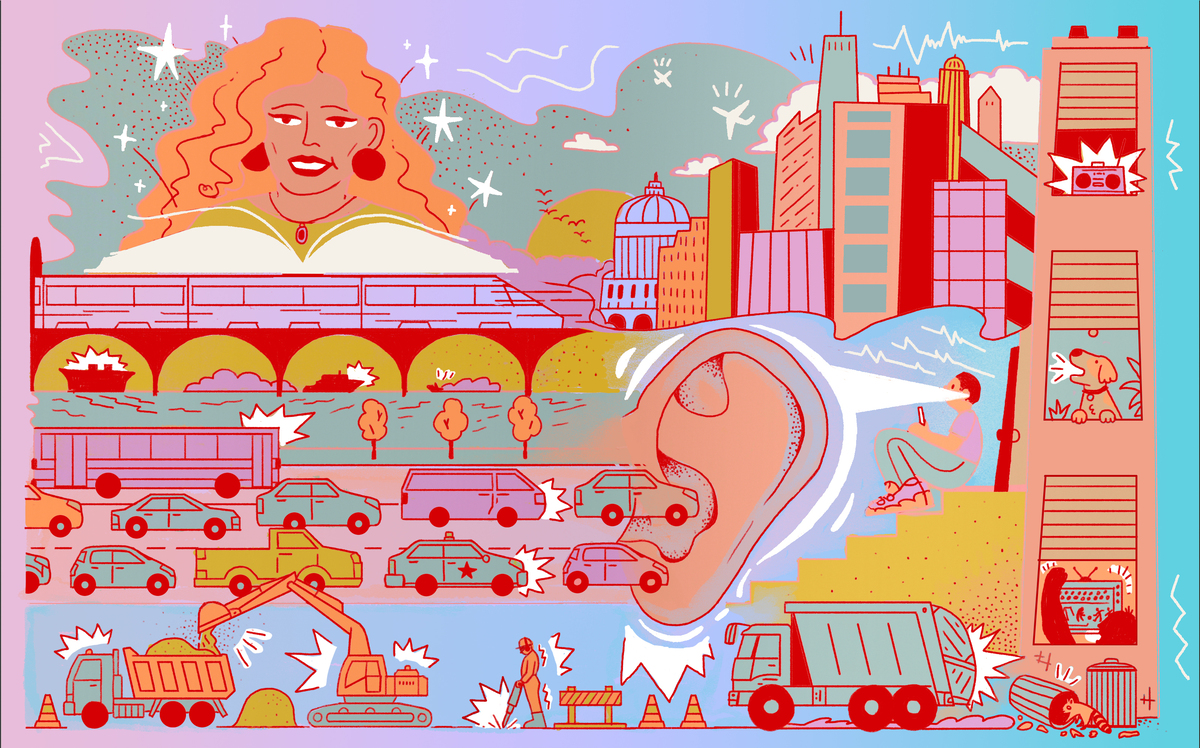
A gaggle of babies sits cross-legged with their instructor, Steve Mejía-Menendez, on a spherical carpet. He is a pre-Ok instructor at Lee Montessori Public Constitution College’s campus in Southeast Washington, D.C., and though I am right here to fulfill him, I virtually do not spot him as a result of he is eye stage along with his college students.
Mr. Steve, as he is identified right here, is speaking a couple of college students by means of a geometry lesson when one other scholar approaches to ask an unrelated query. This sort of distraction occurs on a regular basis in lecture rooms round america. Mr. Steve would not lose focus. He makes use of American Signal Language to say “wait” — palms dealing with up, fingers wiggling — and the kid waits quietly. When the lesson arrives at a pure stopping level, the coed is invited to ask his query, and Mr. Steve silently responds by nodding his head alongside along with his fist, which is signal language for “sure.”
Blink, and you can miss the entire interplay.
This is not a faculty for college kids with listening to disabilities, however Mr. Steve makes use of ASL as a part of a broader method to attenuate noise within the classroom. And it is noticeably quiet. Nobody is speaking louder than what’s typically referred to in Montessori colleges as “the hum.”
“Silence is type of a peak achievement in a baby’s capability to regulate themselves,” Mejía-Menendez says. “We create the situations for youngsters to pay attention.”
In contrast to this classroom, town exterior is stuffed with noise. And research present that an excessive amount of noise, notably loud noise, can harm a baby’s cognitive growth, notably for language-based expertise corresponding to studying. That is as a result of if noise is simply, properly, noise, it distracts creating brains and makes it tougher for youngsters to pay attention. However when their setting is quiet sufficient for them to concentrate to sounds which are essential or notably attention-grabbing to them, it’s a highly effective educating device.
“[Young children’s] brains are craving sound-to-meaning connections, so it is essential that the sounds round them be nourishing and significant,” says Nina Kraus, a neurobiologist at Northwestern College.
She believes turning down the noise in our lives begins with embracing — even having fun with — silence.
Our noisy world shapes our brains
Silence is troublesome to search out and to create — for adults and children alike. All over the world, followers of silence have begun to catalog the world’s disappearing quiet locations. However Lee Montessori is in Washington, D.C., a metropolis that’s surround-sound cacophony: busy highways, screeching commuter trains, jarring automobile horns, waterways with the blare of boat whistles and the seemingly fixed whir of presidential and army helicopters and the drone of business airplanes.
However academics do what they will. Inside this shiny elementary faculty, there aren’t any disruptive public deal with bulletins. College students even put on particular classroom footwear made of material and comfortable rubber soles.
“The listening to mind is huge,” Kraus, the neurobiologist, says. “Our expertise with sound actually does form us.”

In reality, she has written a whole e-book about that matter, known as Of Sound Thoughts. The mind processes auditory enter sooner than visible enter, Kraus explains, and when now we have the area to hear, our brains prioritize what we tune in to and reward paying consideration by means of a launch of dopamine.

For instance, for those who’re a youngster excited to be studying the guitar, musical tones will get preferential remedy. When you’re studying to play basketball, the bounce of the dribbling ball and your coach calling out performs will get your consideration. There are specific sounds, just like the sound of your individual title, that your mind is unconsciously conditioned to answer, even if you’re asleep.
However when sounds are out of our management and never essential to us, they shift into the class of noise: a neighbor’s canine barking at a squirrel, a defective automobile alarm, the drone of a freeway.

When the sounds we’re uncovered to aren’t serving to us be taught a brand new ability or keep protected at a busy intersection, the mind can get distracted and have bother focusing.
It takes brainpower to disregard sound
When the world was quite a bit quieter, our brains paid consideration to each little leaf rustle or snap of a twig as a device for survival, Kraus explains. And when our brains are processing sounds that set off questions like “Am I in bother right here?” or “Can I ignore this?”, there may be much less room to concentrate on the duty in entrance of us.
Take into account a contemporary equal: If you’re listening to somebody inform you one thing and your cellphone dings — Ding! “Is that essential?” — you simply misplaced monitor of the place you had been.
Your mind has to work time beyond regulation to disregard sounds. Contained in the cochlea — the spiral cavity of the inside ear that produces nerve impulses in response to sound vibrations — there are inside hair cells and outer hair cells that work together to amplify or deamplify the vibrations. Say you’re listening to a bit of music on the radio, however visitors noise is within the background. Kraus says your mind will inform the outer hair cells to decelerate and deamplify the visitors noise to guard your ears.

So when there may be even only a average stage of background noise, like visitors or a truck idling, our brains course of extra slowly. Kraus makes use of the analogy of a DJ sitting at a mixing board in your mind, assessing and adjusting sounds that are available all day lengthy. The extra that DJ has to do, the much less working energy is accessible on your mind, making it tougher to course of new data.
It could actually develop into bodily exhausting as properly. Individuals who have bother listening to typically expertise listening fatigue.
Noise is particularly distracting to younger brains
“We are able to shut our eyes, we are able to avert our gaze, however we hear in 360 levels,” says Emily Elliott, a psychology professor at Louisiana State College who research reminiscence and cognition and is without doubt one of the authors of a examine about how auditory distraction impacts a younger kid’s capability to carry out serial recall duties. Elliott and her colleagues devised a take a look at through which they gave younger kids a visible process of memorizing a sequence of things on a display. Then they instructed the kids that sounds can be taking part in however not to concentrate to them, as a result of they weren’t related.
“Typically, efficiency goes down if you’re requested to recollect a sequence of issues so as within the presence of irrelevant or distracting auditory stimuli,” Elliott discovered. “In order that tells us that [the sound is] someway being processed within the cognitive system, as a result of you possibly can’t simply willfully go, ‘I’ll not hear.'”
Elliott and her crew discovered that the essential ingredient of distraction is sound that modifications in some noticeable means. “It might be music with lyrics,” she says. “Music with lyrics is extra distracting than music with out lyrics.”
In addition they discovered that kids underneath age 7 specifically are dangerous at memorization as a result of their brains are usually not but in a position to make use of a key tactic often known as rehearsal. That is the place you repeat issues to your self to recollect them. And never solely will they not bear in mind an inventory of issues, however they’re additionally not conscious that they will not bear in mind them.
So if you’re giving a younger baby instructions or educating a brand new matter and a distracting noise is current, the chances of the kid remembering any of what you’ve got instructed the kid are fairly low.
One examine of New York Metropolis schoolchildren within the Nineteen Seventies discovered that college students in lecture rooms subsequent to noisy elevated prepare tracks carried out considerably poorer on studying assessments than their friends on the opposite aspect of the constructing. After the examine was revealed, town took steps to soundproof the school rooms and reduce the noise coming from the tracks, and a yr later, the scholars’ take a look at scores had been the identical on each side of the constructing.

In one other examine by neurologist Kraus and her crew, they mapped the mind exercise of 66 ninth-graders from Chicago Public Colleges whereas asking them to carry out studying and reminiscence duties. Then they monitored the kids’s electrical mind exercise whereas watching a film and listening to disruptive sounds. They discovered that the scholars who grew up underneath circumstances related to noisier environments carried out poorer on the studying and reminiscence duties and that these college students had what she calls “noisier” brains — which means loads of neurons had been firing on a regular basis, even when the mind wasn’t engaged in a process. You may consider that extra electrical exercise as static.
“And if there’s an excessive amount of static, it makes it arduous to make sense of the entire data that you just wish to be processing,” Kraus says. In keeping with Kraus, extra static in a baby’s mind means it is tougher for that baby to hear and keep targeted wherever they’re.
How silence and a few sorts of noise can profit kids
Kraus believes silence is usually a profit to kids. When she and her crew monitored children with “noisy brains” underneath scalp electrodes, they discovered that intervals of silence helped reduce the static.

Her crew has additionally discovered that making significant sounds, like taking part in a musical instrument or singing, builds and strengthens neural connections.
Different analysis has discovered that pure silence will be therapeutic. In a single examine on mice, scientists tracked mind cell progress amongst mice that had been uncovered to white noise, mice pup sounds, classical music and ambient sounds, they usually in contrast these mice with mice that had been left in silence. The mice that had been left in silence had essentially the most important mind cell progress, main researchers to conclude that the act of listening to silence regenerates nerve cells.
However absolute silence is uncommon exterior a managed lab setting. Even in the course of the woods, you may hear pure sounds of birdsong, the operating water of a stream, leaves rustling and bugs buzzing. Most of these sounds might be described as noise, however they’re calming to us. And if we strive, we are able to discover and re-create these pure sound environments in the course of a metropolis.
Along with being a researcher, Elliott, the psychology professor, can be a mom of three. She discovered early on as a mum or dad to place white noise machines in her children’ bedrooms in order that if considered one of them awoke screaming in the course of the night time, they did not all get up.
“White noise is fascinating as a result of it masks a number of variability in sound,” she says. “It takes out a number of the frequency ranges and presents one thing that seems like a steady, regular sound.” In different phrases, it mimics operating water in a stream, and our brains tune it out.
The sort of noise turns into a profit on this scenario, as a result of it is masking the variability of the opposite sounds that may be a distraction.
Get cozy with the sounds of silence
Creating sufficient quiet to assist hear significant sound is simpler mentioned than finished. Some blame, partially, a tradition that promotes fixed stimulus. “There’s some expectation that you must be loud and flashy to seize your kid’s consideration. Every part must be a enjoyable honest,” says Ellen Doherty, chief inventive officer for Fred Rogers Productions.
Ideas for fogeys
There are loads of methods to create a quiet setting for youths:
Limiting audible distractions throughout essential studying moments, even very early makes an attempt to make phrases, will assist kids improve their capability to focus. If it is homework time, a no-TV rule is a no brainer. Flip off cellphone notifications. Concentrate on not simply sound however timing. One kid’s oboe follow time is one other child’s studying nightmare. Use white noise machines at bedtime or studying time to chop out some frequencies of in any other case distracting sounds. Soundproofing a bed room with carpet, heavy curtains and tapestries can muffle exterior noises. Go to a park or library if you cannot discover quiet at house.
That is the corporate that inherited the mantle of Mister Rogers’ Neighborhood, the kids’s tv program developed within the Nineteen Sixties and identified for its calm and reassuring tone. It is nonetheless producing media for youngsters, together with Doherty’s sequence of shorts, Via the Woods, which is intentionally quiet.
The three-minute shorts are a couple of child strolling by means of the woods, questioning, observing and experiencing. As a substitute of background music, you hear birds chirping, the wind blowing and leaves rustling. The sound designers do a plausible job of creating viewers really feel like they’re within the woods. However Doherty says this sort of programming goes in opposition to the grain of expectations.
“We take our exhibits to focus teams and ask mother and father, ‘Would your baby watch this?'” Doherty says. “And so typically, mother and father say to us that if it is not shiny and flashy, ‘my child will not watch that.'”
Doherty calls that kind of present the enjoyable honest. She believes you possibly can have good exhibits with music and shiny colours that are not distracting however really work to show studying expertise corresponding to how you can handle feelings or calm your self down.
“My metric,” says Doherty, “is does this have to exist?”
“I believe that we’d like to have the ability to honor silence,” Kraus says. “And there is one thing virtually mystical there. You understand, could now we have a second of silence? It is actually a time to type of get into your self.”
Utilizing Doherty’s query, “Does this have to exist?” as a information, we would start to consider silence as an opportunity to be taught and sit up for making our lives quieter.
Edited by Emily Harris and Steve Drummond; visible design and growth by LA Johnson; analysis by LA Johnson; fact-checked by Will Chase; copyedited by Preeti Aroon.









